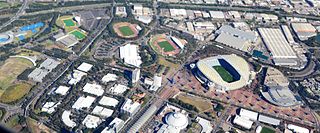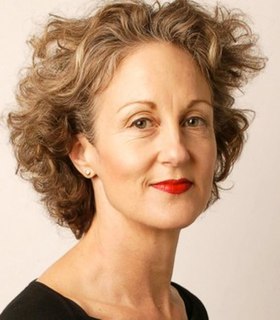Related Research Articles

Walter Burley Griffin was an American architect and landscape architect. He is known for designing Canberra, Australia's capital city and the New South Wales towns of Griffith and Leeton. He has been credited with the development of the L-shaped floor plan, the carport and an innovative use of reinforced concrete.

Castlecrag is a suburb on the lower North Shore of Sydney, in the state of New South Wales, Australia 8 kilometres north of the Sydney central business district, in the local government area of the City of Willoughby.

Marion Mahony Griffin was an American architect and artist. She was one of the first licensed female architects in the world, and is considered an original member of the Prairie School. Her work in the United States developed and expanded the American Prairie School, and her work in India and Australia reflected Prairie School ideals of indigenous landscape and materials in the newly formed democracies. The scholar Deborah Wood stated that Griffin "did the drawings people think of when they think of Frank Lloyd Wright ."

Sydney Olympic Park is a suburb of Greater Western Sydney, located 13 kilometres west of the Sydney central business district, in the local government area of the City of Parramatta Council. It is commonly known as Olympic Park but officially named Sydney Olympic Park. The area was part of the suburb of Lidcombe and known as "North Lidcombe", but between 1989 and 2009 was named "Homebush Bay". The names "Homebush Bay" and, sometimes, "Homebush" are still used colloquially as a metonym for Stadium Australia as well as the Olympic Park precinct as a whole, but Homebush is an older, separate suburb to the southeast, in the Municipality of Strathfield.

The Chinese Garden of Friendship is a heritage-listed 1.03-hectare (3-acre) Chinese garden at 1 Harbour Street, in the Sydney Central Business District, City of Sydney, New South Wales, Australia. Modelled after the classic private gardens of the Ming Dynasty, the garden offers an insight into Chinese heritage and culture. It was designed by Guangzhou Garden Planning & Building Design Institute, Tsang & Lee, and Edmond Bull & Corkery and built from 1986 to 1988 by Gutteridge Haskins & Davey; the Darling Harbour Authority; Imperial Gardens; Leightons; and Australian Native Landscapes. The gardens were added to the New South Wales State Heritage Register on 5 October 2018.
Janet Laurence is an Australian artist, based in Sydney, who works in photography, sculpture, video and installation art. Her work is an expression of her concern about environment and ethics, her "ecological quest" as she produces art that allows the viewer to immerse themselves to strive for a deeper connection with the natural world. Her work has been included in major survey exhibitions, nationally and internationally and is regularly exhibited in Australia, Japan, Germany, Hong Kong and the UK. She has exhibited in galleries and outside in site-specific projects, often involving collaborations with architects, landscape architects and environmental scientists. Her work is held in all major Australian galleries as well as private collections in Australia and overseas.

John Rodney Niland is an Australian academic and board director. Niland obtained a Bachelor and Master of Commerce from UNSW and his PhD is from the University of Illinois. He has held academic positions at Cornell University, The Australian National University, and UNSW. He served as a mediator of labour disputes in the US while at Cornell, and in Australia has undertaken extensive academic and policy work in conflict resolution, theory and practice, particularly enterprise bargaining. John Niland is a Professor Emeritus of UNSW and was its fourth Vice Chancellor and President (1992-2002). Before that he was the Dean of the Faculty of Commerce and Economics. While UNSW Vice-Chancellor, he was a founding director of both Universitas 21 and Australia’s Group of Eight Universities. He also served a term as President of the Australian Vice-Chancellors' Committee, and was a member of the Prime Minister's Science, Engineering and Innovation Council.
Professor James Weirick is an Australian academic who was the Director of the Master of Urban Development and Design (MUDD) program at the University of New South Wales (UNSW), Sydney, Australia.

The Sydney International Regatta Centre (SIRC), located in Penrith, Sydney, New South Wales, Australia, is a rowing and canoe sprint venue built for the 2000 Summer Olympics. It is now a popular sporting venue, with the Head of the River Regatta held annually.

Centennial Parklands is the name given to a group of three urban parklands located in the eastern suburbs of Sydney, New South Wales, Australia. Comprising approximately 360 hectares, the lands encompass Centennial Park, Moore Park and Queen's Park. The Parklands are listed on the New South Wales Heritage Register, with various components of national, state or local heritage significance. The parks are contained within the local government areas of City of Randwick, Waverley Municipal Council, and City of Sydney.
Aaron M. Bolot (1900–1989) was a Crimean-born architect. After migrating to Australia, Bolot contributed to and designed a number of historically significant buildings, including the Flats at Potts Point, registered with the Register of the National Estate for, among other things, its significance in the history of high rise design in Australia.

Kenneth Frank Charles Woolley, AM B Arch, Hon DSc Arch Sydney LFRAIA, FTSE, Architect, was an Australian architect. In a career spanning 60 years, he is best known for his contributions to project housing with Pettit and Sevitt, the Wilkinson Award-winning Woolley House in Mosman, and his longstanding partnership with Sydney Ancher and Bryce Mortlock. He is regarded as being a prominent figure in the development of the Sydney School movement and Australian vernacular building.
Wood Marsh Architecture, styled Wood | Marsh Architecture, is a Melbourne-based Australian architectural practice founded by Roger Wood and Randal Marsh in 1983.

Dr Elizabeth Margaret Farrelly, is a Sydney-based author, architecture critic, essayist, columnist and speaker who was born in New Zealand but later became an Australian citizen. She has contributed to current debates about aesthetics and ethics; design, public art and architecture; urban and natural environments; society and politics, including criticism of the treatment of Julian Assange. Profiles of her have appeared in the New Zealand Architect, Urbis, The Australian Financial Review, the Australian Architectural Review, and Australian Geographic.
Professor Virginia Louise Cox is an Australian architect who has made a significant and distinguished contribution 'to architecture as a practitioner, through executive roles with international professional organisations, and to architectural education and heritage conservation'.
Professor Helen Lochhead is an Australian architect, urbanist and Dean of the Faculty of Built Environment at UNSW Sydney. She is also the 2019 President of the Australian Institute of Architects.
Jennifer Evelyn Taylor was an Australian architect, professor, critic and author who made a significant contribution to writing on contemporary Australian, Japanese and South Pacific architecture.
Penelope Seidler AM is an Australian architect, former member of National Gallery of Australia Council, and current member of the NGA Foundation Board. She is also an accountant and director of the Sydney-based architectural firm Harry Seidler and associates. She was the wife and professional partner of architect Harry Seidler. She was the subject of the 2014 Archibald prize winning portrait by Fiona Lowry.

The Brickpit Ring Walk is an urban nature park and walkway that serves as a water storage and frog habitat, located in the Bicentennial Park, in the Sydney Olympic Park, in western Sydney, New South Wales, Australia. Once a brick manufacturing site, the land was to be redeveloped as part of the site for the 2000 Sydney Olympic and Paralympic Games, however the 1992 discovery of the then endangered Green and Golden Bell Frog placed a hold on developments. The urban nature park and walkway was established in 2006.

The Walter Burley Griffin Incinerator is a heritage-listed former incinerator and now art gallery, artists studios and public recreation area at 2 Small Street, Willoughby, City of Willoughby, Sydney, New South Wales, Australia. It was designed in partnership between Walter Burley Griffin and Eric Nicholls and built from 1933 to 1934 by Reverberatory Incinerator and Engineering Company and Nisson Leonard-Kanevsky. It is also known as Willoughby Municipal Incinerator. The property is owned by the Willoughby City Council. It was added to the New South Wales State Heritage Register on 2 April 1999.
References
- ↑ "2018 AILA ACT Landscape Architecture Awards". Australian Institute of Landscape Architects. Retrieved 20 July 2019.
- ↑ "Check Landscape Architect Registration". Australian Institute of Landscape Architects. Retrieved 20 July 2019.
- ↑ Bull, Catherin Jane (2002). New Conversations With an Old Landscape: Landscape Architecture in Contemporary Australia. Melbourne: Images Publishing. p. 66.
- ↑ "A Celebration Of Oi Choong's Achievements". Conybeare Morrison International. 13 November 2014. Retrieved 20 July 2019.
- 1 2 "Luminary Oi Choong: "Be Brave. Be Amazing. Be Worthy."". Street Furniture Australia. 16 April 2019. Retrieved 20 July 2019.
- ↑ "Significant Landscape: Sydney Olympic Park, Homebush Bay, Sydney". Australian Institute of Landscape Architects. Retrieved 20 July 2019.
- ↑ Landscape Australia, Millennium Parklands
- ↑ "Winners announced: 2018 ACT Landscape Architecture Awards". Landscape Architecture. 8 June 2018. Retrieved 20 July 2019.
- ↑ Saniga, Andrew (2012). Making Landscape Architecture in Australia. Sydney: UNSW Press. p. 288.
- ↑ Willow, Aliento (10 July 2018). "NSW architecture awards stars sustainability and innovation". The Fifth Estate. Retrieved 20 July 2019.
- ↑ "Marion Mahony Griffin Prize". NSW Architecture Awards. Retrieved 20 July 2019.
- ↑ "2018 NSW Architecture Awards". Architecture AU. 6 July 2018. Retrieved 20 July 2019.